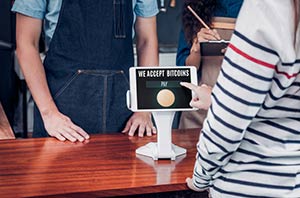Three Ways Bitcoin Is Like Regular Currency
Wednesday, April 25, 2018By Christine Smith, Public Affairs Staff
Thinkstock/WeedezignEven though bitcoin and other cryptocurrencies may seem exotic, they share some qualities with regular currency. Here are a few ways that bitcoin is like the cash you know, whether in principle or in practice.
1. No Intrinsic Value
Economists Aleksander Berentsen and Fabian Schär explained in a recent St. Louis Fed Review article that bitcoin units have no intrinsic value. In economic terms, something lacking intrinsic value means it has no value of its own. But as the authors noted, “tate monopoly currencies, such as the U.S. dollar, the euro, and the Swiss franc, have no intrinsic value either.”
Let’s unpack that.
Digital currencies exist as data. The cash in your wallet exists as a blend of 75 percent cotton and 25 percent linen. Neither is inherently valuable.
Compare that with commodity money, like gold or silver. Or representative money, a certificate or token that can be exchanged for an underlying commodity such as gold. Since the U.S. left the gold standard, the paper money in your wallet doesn’t represent gold, yet you are still able to purchase goods and services with it.
Our government has declared the dollar to be legal tender. Federal Reserve notes, then, are fiat currency.
There is ongoing debate about how to characterize bitcoin: Currency? Asset? Investment? No matter how you view it, bitcoin units have no intrinsic value.
2. There’s a Limited Supply
The Fed does not print money. It can, however, increase or decrease the monetary base. Essentially, the monetary base is made up of the reserve balances that depository institutions (like banks) hold with the Fed, plus currency in circulation.
That $20 you forget in your coat pocket? Technically, it’s in circulation.
How much U.S. currency is out there? According to the Federal Reserve Board of Governors, approximately $1.63 trillion as of March 21. Of that, $1.59 trillion was in Federal Reserve notes.
While it’s hard to call a trillion-plus dollars scarce, scarcity is one of money’s core characteristics: To maintain its value, money must be in limited supply. The Fed, as our nation’s central bank, carefully calibrates the supply of dollars to promote stable prices and maximum employment.
No central bank controls the supply of bitcoin. Its price fluctuates, sometimes wildly. Yet there is an upper limit to its volume. As Berentsen and Schär note, its creation is scheduled so that the number of units can ultimately converge to a cap of 21 million.
3. No Middle Man
Berentsen and Schär explain that bitcoin’s origins stem from a whitepaper published under the name Satoshi Nakamoto. In that document, the author (or authors) describe a vision: “A purely peer-to-peer version of electronic cash would allow online payments to be sent directly from one party to another without going through a financial institution.”
In that way, bitcoin was designed to be a lot like cash.
Cash requires no intermediary to process a transaction. Unlike paying with a credit card or an app, no third party adjusts your account.
Furthermore, wrote Berentsen and Schär, “No credit relationship arises between the buyer and the seller. This is why it is possible for the parties involved to remain anonymous.”
- Forums
- CFDs
- Bitcoin
Three Ways Bitcoin Is Like Regular Currency Wednesday, April 25,...
-
- There are more pages in this discussion • 100 more messages in this thread...
You’re viewing a single post only. To view the entire thread just sign in or Join Now (FREE)










